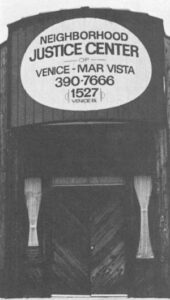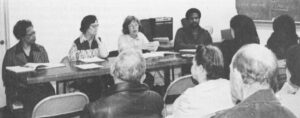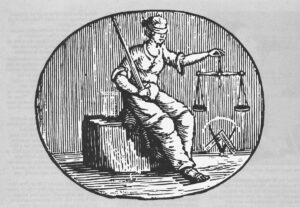
(Photo by Tia Schneider Denenberg)
(LOS ANGELES) — A pickup truck with a camper mounted on the back pulls up to a curtained storefront on Venice Boulevard. The driver and passenger, a couple in their twenties, enter an office furnished with three desks and a faded brown corduroy couch. A staff member welcomes them to the Neighborhood Justice Center, ushers them into a closet-like side room and introduces them to “your mediator, Sharon Shapiro.”
They take seats around a small table, and the door closes. An hour and a half later the door opens, and out walks the mediator clutching a child support and visitation agreement signed by the couple and herself. It will take effect upon the couple’s imminent divorce.
The husband and wife have just reaped the benefits of a grassroots movement toward lawyer-less, no frills conflict resolution. It is called community dispute settlement, or, as befits the Venice Boulevard operation, “storefront justice.” Propelled by the hefty price and meager satisfactions of conventional justice, the movement has been burgeoning. About 100 programs similar to the neighborhood center have sprung up within the last dozen years throughout the country, nurtured by foundations and local or Federal government grants. The U.S. Justice Department, which funds the Los Angeles center as a pilot project, sponsors two others, in Kansas City and Atlanta. San Francisco has its foundation-backed Community Board Program, Miami its Citizen Dispute Center, and Boston its Urban Court.
Dispute settlement’s proponents offer it as an alluring alternative to a judicial system that has become remote from the everyday lives of most people, particularly those with modest incomes. Courts, they argue, are inaccessible, because their procedures are chillingly formal, their delays seemingly endless and their costs — most litigants feel vulnerable without a lawyer — prohibitive.
For all their elaborateness and expense, say the proponents of dispute settlement, courts are ineffectual. Explains Raymond Shonholtz, founder and director of the San Francisco program, the court is seen as delivering “neither restitution nor punishment. Therefore, few people willingly participate in it, and most strive to avoid it…. It forces individuals and communities to tolerate disputes until they fester to the point of urgency.”
Moreover, the proponents contend, disputes are inherently unsuited to a winner-take-all judicial confrontation when the parties have a long-term relationship that may continue after they leave the courtroom. Mitchell Sviridoff, a vice president of the Ford Foundation, which has invested heavily in dispute settlement programs, laments that “we are increasingly bringing to an adversarial bench disputants who are not in fact adversaries, or at least who are not only adversaries, but who are spouses, friends, lovers, relatives, neighbors.” In a child custody case, observes Maurice Rosenberg, head of the U.S. Attorney General’s Office for Improvements in the Administration of Justice, “the interests of the spouse, the child, and society generally calls for something other than that a total victory for one side and total defeat for the other be proclaimed.”
In contrast to the courts, dispute settlement offers a forum that is typically free, informal and expeditious. The neighborhood centers welcome the conflicts that courts find too trivial or too elusive: domestic quarrels, squabbles with neighbors, disagreements between customers and merchants, misunderstandings between landlords and tenants, simmering animosities among ethnic groups. The object is neither to judge guilt or innocence, nor to affix blame. The goal, rather, is to find a compromise solution that, in the jargon of the craft, “both sides can live with.” The principal technique, borrowed from labor-management relations, is mediation — an attempt by a neutral third party to affect a mutually acceptable, voluntary outcome. At times, the neutral may step up to the more potent role of arbitrator; both sides agree in advance to let him decide the outcome. To make the disputants feel more comfortable, the neutral is normally a volunteer drawn from the neighborhood.
The centers pride themselves on eliciting settlements that are more effective and enduring than court decrees by eliminating the tensions which underlie the surface conflict and which may flare up again if left unresolved. Few courts are equipped to offer such diagnostic and preventive services.
Transcending the immediate practical benefits is a visionary ideal: returning the process of resolving conflict to the community at large after a long period in which that function has been usurped by a professional caste of lawyers and judges in an impersonal institution called a court. It is a kind of judicial populism. In this instance, power to the people means the power to handle their disputes in their own way. Says Robert Pryce, associate director of the Los Angeles center, “Our caseload may be low, the time we spend mediating may be longer than any court spends on a case, but the humanistic, voluntary tendencies we promote is what makes us worthwhile.”
Both the theory and the practice of dispute settlement have been evolving since the urban unrest of the late 1960s. One the earliest projects was Philadelphia. It began diverting minor criminal cases from the courts in 1969, putting them before arbitrators. At the same time, legal scholars began proposing the creation of “community courts” or “community moots,” with varying degrees of coercive power.
A turning point was the 1976 Conference on the Causes of Popular Dissatisfaction with the Administration of Justice, sponsored by the American Bar Association. A follow-up report called for “new mechanisms for the delivery of justice,” including Neighborhood Justice Centers. The task force that issued the report was headed by a Federal judge from Georgia named Griffin Bell. The next year, as Attorney General Bell, he took steps to put his own recommendation into practice experimentally.
When the Los Angeles center opened in March, 1978, it found that storefront justice did not necessarily draw a brisk walk-in trade. So it did what any other enterprise would do to stimulate business: it advertised aggressively. There were public service ads on radio, television spots, and posters on buses (“Call 390-7666. A Free Community Mediation Service”). In one sense, the center’s “outreach” campaign worked too well; people telephoned to grumble generally about their spouses, landlords and neighbors — complaints that did not amount to specific disputes. Some callers were under the impression that it was a free legal aid center. They wanted to sue someone.
Eventually, the cases came. A recent Federal evaluation counted 751 disputes during a 15-month period, about a third of them resolved. The Atlanta and Kansas City centers drew considerably more and resolved a higher percentage. But unlike Los Angeles, they routinely accepted cases referred by courts, prosecutors and the police. “There is no doubt that we took a hard road,” Pryce says. “But programs that use direct referrals from the courts have taken the choice away from the parties. “
In the eyes of the Neighborhood Justice Center, it takes two persons to make a dispute: the “initiator” and “the respondent.” Says Pryce, “The respondent is the one that we must persuade. We do everything short of using force or threats. We tell them the benefits. We tell them they have a problem that might end up in court. Nothing happens unless you persuade the respondent to come in.”
When it does get both parties around the table, “they are fuming and angry and full of disgust at each other,” says Pryce. “Then there is this magic that takes place — one person begins to hear what the other is saying and that he has some legitimate interests that are being infringed. They see possible areas of compromise. And at the end, they feel good about it. We want people to have good feelings about the process of resolving disputes. Otherwise, it’s no different than a court, where you are compelled to accept a solution.”
Sharon Shapiro, one of the center’s 18 part-time mediators, describes her approach as “trying to get both sides to feel they are getting something out of the mediation session. If both are satisfied they’ve received something, then I’m satisfied. And I’ve got a good batting average.” In the child support case she had just handled, “both were willing to compromise without name calling. Sometimes there’s a lot of yelling and screaming.”
Mediators require not only sensitivity but stamina. The child support case was relatively short, but she has sat patiently through four-hour sessions. Seven hours is the center’s record. Such marathon mediations are sometimes necessary to bring the real conflict to the surface. “Courts are just about money,” Ms. Shapiro says. “Here there are a lot of personal things going on.”
In one dispute she mediated, a boat owner ordered an engine repairman off his craft and refused to pay the $1,100 balance of the bill because the job was taking too long. The dispute was bitter, even though or because — the two were old acquaintances. It took much of the three-hour session just to get the boat owner to face the repairman and talk to him directly. Even then, a stalemate ensued. The mediator caucused separately with each man, producing an offer of settlement by the boat owner. It was refused by the repairman. At the end of the session, the best that could be accomplished was to have both disputants sign an agreement to meet again for face-to-face negotiations. Although the dispute was not over, a breakthrough had been made.
Ms. Shapiro is paid $6 an hour while mediating, but the real rewards are intangible: “I like to feel I’m helping people.” The mediator walks a fine line, making suggestions about possible compromises but never telling the disputants what they should do. It is their agreement, and she avoids imposing her values. But she does try to see “that it’s as complete as possible,” that all points of possible contention have been removed and that the terms are clear. Even the handwriting must be checked; an illegible agreement might lead to misunderstanding later on.
Follow-up studies determine how well the agreement is working. If it seems to be disintegrating, “re-mediation” may be suggested. The center also provides an extra service: referrals to a network of helping agencies. “We get people in here,” says Pryce, “who have not one problem but three or four. We handle one, and we get them to places where they can get help for the others.” Battered wives may be sent to shelters, the emotionally disturbed to mental health centers, and drinkers to Alcoholics Anonymous. If someone has a genuine legal difficulty, the center will even suggest a lawyer.
The Los Angeles center’s methods are by no means standard. There are a plethora of approaches, as is evident in the contrast between the center and another California program, the San Francisco Community Board, founded in 1977. The conflict resolving sessions of the Board are public rather than private, and the neutral presence is not a single mediator but a three-person panel. The hearing is a cross between a mediation and a town meeting at which communal solidarity is reaffirmed.

Paul Rupert, the program manager, calls the method “conciliation,” because it emphasizes face-to-face dialogue between the disputants with few caucuses. “I’m always fascinated,” he says, “by someone who complains for years about the neighbor’s Labrador retriever but, when asked what’s the neighbor’s name, says, ‘I don’t know.’ He’s never tried to talk to him.” In criminal matters, says Rupert, “if you bring together the perpetrator and the victim face-to-face, something will happen. You’ll get the perpetrator to take responsibility. It’s non-coercive self-criticism.”
The board’s technique reflects its primary goal: neighborhood stabilization and cohesion. Purely domestic disputes, Rupert acknowledges, are few, probably because of the openness of the forum. The atmosphere is more conducive to airing matters of common significance — particularly juvenile crime, vandalism, and what Rupert calls “lifestyle-value clashes.”
The neighborhoods of south-eastern San Francisco offer fine laboratories for testing the technique. Set among the urban “valleys” of the city’s corrugated topography, they have a relatively well-defined physical identity. A ridge of hills, for example, cloisters Visitacion Valley, one of the four neighborhoods the Board serves. Each is a microcosm of the city’s kaleidoscopic ethnic and economic makeup: a white plurality and smaller groups of blacks, Latinos and Chinese. The program newspaper has even carried announcements in Tagalog, a Philippine language.
In recent years, some sections have acquired a gay middle-class. Among the lifestyle clashes that the Board attended to were name calling incidents, involving gay homeowners and Latino youths. In another exercise in inter-group relations, an Asian grocer filed a complaint against a black 12-year-old who had robbed his store; the grocer was unwilling to take the matter to the police, partly because he wished to avoid alienating blacks who were his customers.
In some instances, the panelists, who serve six-month terms, help the denouement by playing a personal role. An eviction dispute was resolved through the efforts of panelists to find the tenant a new place to live.
Although the panels ostensibly are not out to find fault, the upshot of a session involving incidents such as theft may be a penalty. Restitution or a specific number of hours of community service may be required. And the panelists’ own notion of what is a just outcome influences the ultimate agreement. One dispute, for example, involved a homeowner and a teenage girl who was part of a group that had attempted to burglarize his house. A member of the panel told a reporter afterward that the homeowner might have been willing to let her get off by simply saying she was sorry: “So the panel kept working at it until a reasonable agreement was reached.” The reasonable agreement was that the girl would do 20 hours of cleanup work in a park. As No. 5 of the board’s “underlying principles” stresses, the “panel will resolve cases in a matter which is satisfactory to both parties and to the community.”
Paradoxically, while dispute settlement offers the poor ready access to a forum where they can press their grievances, there are some who fear that it may be considered a second-class system of justice for those who cannot afford to go first class. Courts are respected, it is argued, precisely because they are expensive and involve highly paid professionals. At a recent meeting of the National Council on the Role of the Courts, a Justice Department advisory body, one member cautioned that “anything that is done on the cheap is going to be regarded as inferior.”
Some legal experts also worry that the constitutional rights of disputants may be trampled inadvertently in the rush toward informality. “An especially sensitive or confused individual,” suggests Frederick E. Snyder, an assistant dean of Harvard Law School, “might easily interpret the zeal of the mediators as the demands of people who occupy positions of authority in the criminal justice system. He might volunteer incriminating information that one way or another could be used as evidence or lead to evidence in a criminal proceeding later launched against him.”
Lawyers’ organizations, though, have looked kindly upon dispute settlement, in large part because they view it as a means of thinning out the serried ranks of cases awaiting trial. The supporters of dispute settlement are concerned. “Most of the programs that claim to reduce court caseloads are kidding themselves,” says Rupert, “It’s a funding game that we’re not into playing.” Neighborhood centers may give judges’ calendars little relief because, for one thing, the disputes they attract would never be taken into court. Besides, argues Howard S. Bellman, a vice president of the Wisconsin Center for Public Policy, “mediation should be offered because it’s a better way to resolve disputes — not because it’s a way to relieve courts. Otherwise, you may mimic the courts in their worst abuses. You may end up with a trillion cases that you can’t handle.”
Some practitioners also agree with Pryce that direct linkage with the court system, while providing a temptingly automatic source of cases and funds, introduces an unwanted element of coercion. A criminal defendant, for example, may agree to mediation only because he believes he will be prosecuted otherwise. Close connection with the court system could also transform what is now a flexible forum into a rule-ridden adjunct of the very judicial bureaucracy it was supposed to supplant. The Kansas City center was run directly by the municipal government, and Federal evaluators found that as a result it was hampered by having to comply with standard paperwork and personnel regulations. One rule limited flexibility by making it difficult to assign staff members to positions for short periods.
Another potential source of funding, apart from the courts, recently dried up. The Dispute Resolution Act, signed by President Carter earlier this year, authorized $10 million to support neighborhood programs. But the Office of Management and Budget has blocked the appropriation on fiscal grounds.
That leaves dispute settlement with the challenge of finding another way to turn ephemeral storefronts into permanent institutions. Many of the centers are running on seed money grants that temporarily pay the rent and the staff members who support the neighbor-mediators. But as Paul Wahrhaftig, a Pittsburgh-based organizer, has asked: “Can one rely on the neighbors when they are not backed by a foundation?”
Some dispute settlement planners are willing to try. They are, in fact, moving away from affiliation with government, from big offices and from big budgets. They are contemplating a utopian withering away of the staff. Their aim is to train a cadre of citizen mediators who will function with negligible overhead. The Community Board’s goal is to have mediators scattered throughout San Francisco with only a skeleton crew at a central training headquarters. Ultimately, some believe, dispute settlement will become a state of mind bereft of corporal existence. “We are attempting,” explains Pryce, “to instill in people the ability to solve disputes among themselves, without courts, lawyers — or even centers like ours.”
©1980 Richard V. Denenberg
Richard V. Denenberg is investigating “Alternatives to Traditional Courts.”






